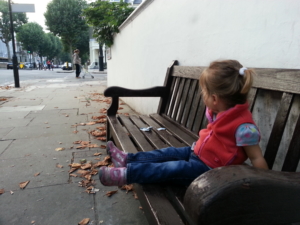Channeling family travel excitement
Ours is a house of artists. I use words to express myself; Powerwoman and our daughters use images. My wife and older daughter in particular turn to drawings and sketches when they wish to express deep and personal thoughts. This means pre-trip excitement often sparks a ton of art time.
Usually L is the queen of this handiwork, cranking out single sheets and books about the things she thinks we’ll experience on the road. (To R’s credit, she’s still working on the whole hold-a-marker-the-right-way trick.)
This week, however, my wife has run point.
The fruits of her labor: A book about our August trip to Walt Disney World. Because we’ve never been there as a family (we’ve only taken the girls to Disneyland), the girls have been pestering us about what it’s like and what they’ll see. Yes, we answer them when they ask. But to sweeten the storyline, Powerwoman started a book (quite literally) to illustrate our replies.
The first page of the book presents a map of Fantasyland, complete with images of the carousel and the iconic Cinderella Castle. A rough strategy for subsequent pages include a rendering of Arandelle (our girls, like all girls, are obsessed with Frozen), Epcot Theme Park, and more.
As of today, the expectations were for Powerwoman to create one new page a week. You better believe the girls intend to hold her to this schedule. The penalty: Incessant nagging.
In all seriousness, the book has been a huge hit. It’s also been a great inspiration—as if L and R weren’t excited already, the book (and discussion about it) has jump-started their interest in a big way. By the time August rolls around, the girls likely will be bursting at the seams for the conclusion of their pre-trip primer. I’m also looking forward to using it as a distraction tool on the six-hour plane ride to Orlando.
This whole process has taught us a valuable lesson: It’s never too early to get your children excited about upcoming family trips. Anything that sparks their imagination, anything that triggers and encourages excitement about travel, is worthwhile. Especially if it involves creativity, too.
How do you get your children excited for upcoming family trips?











